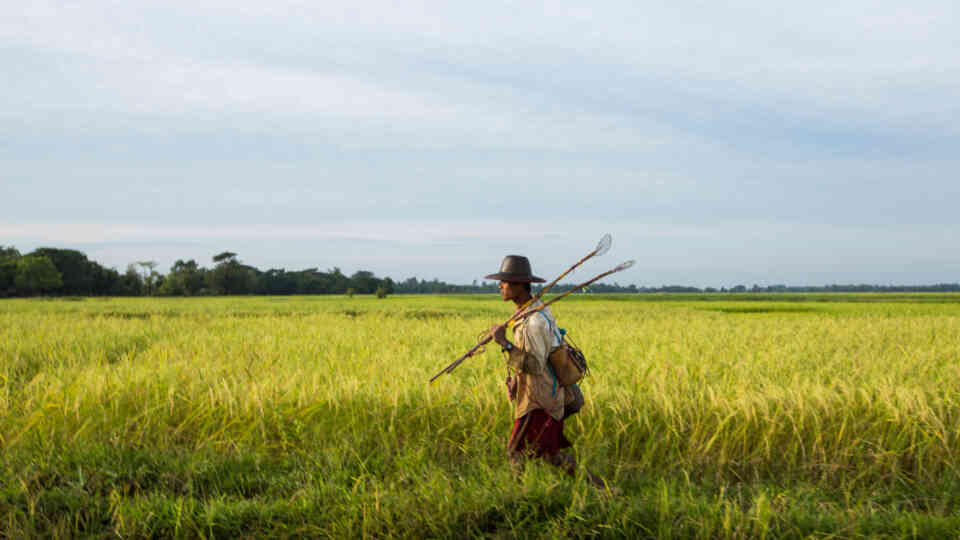The United Nations Office for Project Services (UNOPS)

Healthcare closer to home
Some 200 kilometres south-east of Yangon, a new healthcare centre is serving the township of Thaton in Mon state, Myanmar – home to around 275,000 residents. The Pawdaw Mu health centre is just one of 21 centres built with funding from mobile telecommunications operator, Ooredoo, to address dire health needs across the country.
“Mingalarbar,” says Midwife Khin Cho Cho Thet – a common greeting in Myanmar – as she meets patients waiting for examination. Residents from nearby villages come to the centre for a range of medical symptoms, from common colds and diabetes, to receiving pre- and ante-natal care as well as vaccinations and contraception.
In a country with one of the highest maternal mortality and under-five mortality rates in Southeast Asia, improved quality of services at healthcare centres and clinics is desperately needed to strengthen the healthcare system and improve access to health to all, including underserved and vulnerable communities. Every day, women die from preventable causes related to pregnancy, childbirth and complications in the first few weeks after birth. Maternal mortality rates vary depending on the state and region, but are significantly lower in urban areas where women can give birth in a facility that provides basic and emergency obstetric care.
Just a few months back, access to healthcare services in Thaton was very different. Community members had to travel long distances to the main hospital, which was particularly challenging for the pregnant and elderly, and often dangerous at night. Now, the community healthcare centre has opened its doors and serves around 10 - 12 patients daily.
“The health centre is open from Monday to Friday. On Thursdays we see women at all stages of pregnancy. Wednesdays are dedicated to the elderly. But we see all of the patients whenever they come. Every time we receive public medicine for free, we provide them to our patients,” says Midwife Khin Cho Cho Thet.


This clinic is convenient, clean and safe with all the necessary facilities.
Importantly, the new clinic is fully equipped and has adequate space for childbirth. “We used to have to go to the woman’s house to help them give birth,” describes Khin Cho Cho Thet. “As you know, houses aren’t as clean as clinics. Most of our patients are really poor. This clinic is convenient, clean and safe with all the necessary facilities.”
Khin Cho Cho Thet became a midwife after her father passed away, and she had to take care of her mother who was often sick and in the hospital. She hoped by becoming a midwife she could help take better care of her mother, and they wouldn’t have to go to the hospital as often.
She reflects on a time when a woman, who lived in a paddy field outside the village, came to her clinic asking for help during childbirth. Two of her four children had died shortly after birth due to an infection in the umbilical cord. For her, giving birth was complicated.
“We treated her as much as we could with what we had learned from the gynaecologist… she lost a lot of blood during the delivery,” says Khin Cho Cho Thet.
She further explained that because the woman lived in a paddy field where no medical services were available, extra precaution was taken:
“We had her stay longer in the clinic, and I took care of her. She was very grateful. On the fourth day, the baby’s umbilical cord fell off and I let her go home with the medicine that she needed to take.”

May Nwe Oo
May Nwe Oo is visiting the healthcare centre for a diabetes blood test. Her son, four-years-old, also visits the centre when he falls ill. “It is really convenient to have the health centre here in the village because the hospital in the city is really far away,” says May Nwe Oo.
She continues: “The midwife here is available 24 hours because staff housing is located in the health centre compound… Everything here is clean and tidy, it’s like a hospital including the layout and support.”
Not too far away, a new healthcare centre in Kyaikhto, another village in Mon state, is also providing healthcare services a little closer to home.
Phyu Phyu Htway
Phyu Phyu Htway gave birth to her second daughter, Shwe Sin Htun, at the clinic six months ago on a Saturday. “I was thinking about giving birth at my own house at first. But it is difficult to give birth at home and it is difficult for the midwife to come and go. So I chose the clinic and I gave birth here. It is very clean and I’m satisfied."
Phyu Phyu Htway left the healthcare centre three days after giving birth, which is standard practice at the centre.

“After the woman gives birth, she stays for three more days, while the father comes and go[es],” describes Midwife Nwe Ni San. “Every morning, we check the blood pressure and we check that breastfeeding is working well for the mother and baby.”

Soe Soe Thin
Soe Soe Thin, who lost her first child, gave birth to her baby boy in the healthcare centre four months ago. She describes her experience: “I called the midwife in the middle of the night at around three or four in the morning when the symptoms started, and I arrived at the clinic early in the morning. The baby was born at 8:15.”
The midwife, who carries a cell phone with her at all times, is ready for when her patients call her during the early stages of childbirth. Soe Soe Thin continues: “After the birth, the midwife provided vaccinations, and they taught me how to breastfeed, and the importance of only breastfeeding for the first six months.”
Today, Soe Soe Thin visits the clinic on a monthly basis to receive vaccinations and have general checkups. Just a five minute walk from her home, she appreciates the ease. She adds: “It is better here because everything is clean and tidy. The midwife stays close and is very helpful.”


Across nine states and regions, 16 healthcare centres are now serving communities in need, with five more on the way. By bringing services closer to home, those living in rural and peri-urban regions have a better chance at receiving the healthcare they may desperately need.
Investments like these in health infrastructure are key to helping accelerate Myanmar’s progress towards reducing maternal mortality, ending preventable deaths among newborns and children under five, and reducing the neonatal mortality rate. This partnership between Ooredoo and UNOPS is one example of how the public and private sectors are working together to support the achievement of the Sustainable Development Goals (SDGs), and the national SDG priorities of countries such as Myanmar.
Project details:
In an effort to help combat high maternal and child mortality rates in Myanmar, UNOPS has partnered with mobile telecommunications operator, Ooredoo, who has invested $3.1 million to build 21 primary healthcare centres in rural and peri-urban communities throughout the country. Working closely with the Ministry of Health and Sports, the centres serve community health needs, with a focus on maternal, newborn and child health.
The centres are built with sustainability in mind: the buildings are designed to resist natural hazards, such as earthquakes and wind loads, and they incorporate the use of renewable power sources and waste management technology.
To date, the construction of 16 healthcare centers has been completed, with ongoing construction at five healthcare centres. The project is also helping improve livelihoods and local economies by creating jobs for local workers. In 2017, approximately 48,000 labour days were created for local workers, of which more than 6,000 days were created for women.











